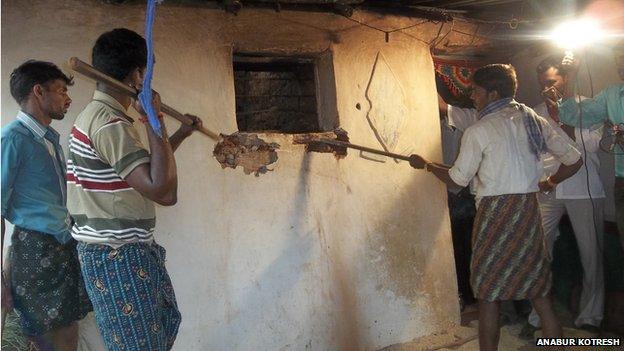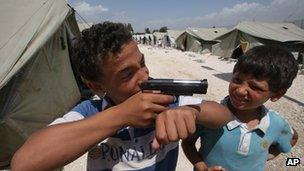Mentally ill Indian's hidden decade in solitary
- Published

Officials use sticks to break into the room where Keshava had been confined for more than a decade
Last October in a village in southern India, a crowd of thousands gathered to watch officials smash down the wall of a house to release a man who had been incarcerated for more than a decade.
Keshava had been locked up alone in a small windowless room without a door and just a tiny opening for ventilation that doubled as a hole through which to serve food.
For years his family had tried to get him help for his mental health problems. As his symptoms worsened they despaired.
Finding it increasingly hard to cope, they hid him in a back room when people visited and eventually resorted to bricking him up in a room.
Keshava was released after a senior official in the nearby city of Bangalore read about his case in a newspaper.
On arriving at the village, regional commissioner K Shivaram was shocked at what he discovered.
"Immediately, I told my people to break open the wall. There were 2,000 people gathered watching what we were doing. A very bad stinking smell was coming. We couldn't even peep into the room. It was a very bad state of affairs."
The man, believed to be in his late 30s, emerged weighed down by a mass of matted hair. Mr Shivaram, who believed Keshava had not washed for a decade, swiftly organised a haircut, a bath and a medical examination.
Shortage of care
His story is extreme, but Keshava is far from alone in not getting the treatment he needed.
The World Health Organisation estimates that in low and middle-income countries only one out of five people with mental health, neurological or substance-related problems has access to appropriate services.
The search to solve this problem raises important questions about mental health.
Do people everywhere experience the same conditions and respond to the same treatments, such as medication or talking therapies?
Or are our beliefs about our minds so tightly bound to the culture in which we live that local solutions provide the best chance of recovery?
There are even questions about what constitutes a disorder. From time to time we all find ourselves in some kind of emotional turmoil or distress.
But when do everyday anxieties, unusual thoughts or low moods tip over into something that is defined as a mental health problem? Who decides what is normal?
Does one size fit all?
Mental health experts debate these issues fiercely.
Prof Vikram Patel, of the London School of Hygiene and Tropical Medicine and the Sangath Centre in Goa, western India, believes that mental health care needs to be boosted in low and middle-income countries.
"In the developed world we have a situation where there is genuine concern of overuse of drugs and overmedicalisation of everyday life.
"In the developing world it's the opposite. Half of those with psychosis get no treatment at all and many individuals are chained or locked up."
He believes that "while we must be cautious" there should be better access to "evidence-based interventions for people with mental disorders".
But not everyone agrees. Pat Bracken, a psychiatrist and clinical director of a mental health service in Ireland, is critical of conventional psychiatry.
While acknowledging the human rights issues in some places with mental health care, he worries about the globalisation of Western notions of mental health.
He favours local solutions and wants to build on the experiences of each community to take into account their own culture's explanations of mental distress.
"What will work for people in New York or London will not necessarily work for people in rural Africa or rural India," he says.
"We have got to stand back from the idea that there is some great Western technology that is somehow being withheld from people in the developing world. That's not the case."
Norway's pioneering approach
Richer countries such as Norway went to extraordinary lengths to provide help to those caught up in the mass murder of 77 people in Oslo and an island youth camp by Anders Behring Breivik in 2011.
Norwegian health officials, faced with large numbers of traumatised and bereaved people spread across the country, pioneered nationwide weekend gatherings for the bereaved, their friends and families, with intensive and professional support.
Curiously, when younger children face traumatic situations, such as in conflict zones, they are not always offered help because it is often assumed that they "bounce back".

Children caught up in conflict zones often do not get all the help they need
Atle Dyregrov, director of the Children and War Foundation in Norway, says children do not always cope in this way.
"Yes children are resilient, but it's also a belief that adults want to hold because we don't have to take responsibility if we say that children are resilient.
"War affects children. It's not like they just go through this and most of them do well. These craters in the mind don't go away just by pretending it hasn't happened."
His research suggests that while at least two thirds do recover without help, the rest will continue to suffer.
War children
War brings multiple traumas: the witnessing of atrocities, the loss of family members, friends and home and often the move to a new place.
In Jordan, where many have fled the bloodshed in neighbouring Syria, child refugees are receiving mental health help with minimal resources.
Dr Dyregrov and his colleagues trained a core group of volunteers in simple cognitive techniques that can help the children to deal with nightmares, disturbing memories or difficulty sleeping.
One technique is to ask the children, when troubled by a memory, to picture the traumatic scene in front of them, then imagine minimising it as though on a touch screen until it vanishes.
This does not mean that the same solutions work everywhere. Even the symptoms of distress that people experience vary around the world.
Label behaviour
In Tokyo, legions of young men have a condition known as hikikomori, where they withdraw from life, sometimes staying in their rooms for years at a time.
There might be as many as a million people living this way in Japan. A proportion might fulfil the criteria for psychosis in the West, but not most.
Inevitably when any of us decides what is normal and what is not, we label behaviour and experiences according to our own cultures.
Meanwhile, after Keshava was taken to a treatment centre in Bangalore, his symptoms of psychosis have lessened, but he is suffering from all those years spent in solitary confinement.
There is still no care available in his village, so he is likely to move to rehabilitation centre next. It is not known when he might return home.